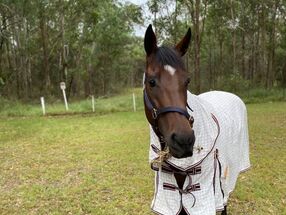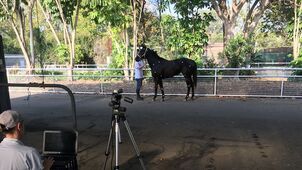|
"I am a mum returning to the saddle after having a baby. I am really struggling with my 'feel' in the saddle. It is much harder to feel the horse moving under me, and I struggle to know if I am in the right position. How can I fix this? ”
Read on to hear Hannah's (physiotherapist) response to this.
0 Comments
By Hannah Mauldon
Returning to the saddle after having a child is a really important journey that many riders will experience. While you should not feel rushed to be back in the saddle, the six-week postpartum check is largely considered the point where medical clearance to return to normal activity occurs. However, it is becoming more clear that appropriate musculoskeletal interventions, typically prescribed by a qualified physiotherapist, could safely begin in the immediate postpartum period. What are some of the key areas that change when you are pregnant and how can working on these improve your riding? When it comes to exercise prescription for injury rehab & performance, there is never one right exercise (despite what ‘experts’ on social media may tell us!) What is really important is getting the ‘dosage’ or load right.
We recently asked our physiotherapy team a hypothetical question that is a common problem many of our para patients face. Click below to read the answer.
“I’m a para rider with limited leg use due to my injury. I’m really struggling to keep my horse straight and some lateral movements are a challenge, especially leg yield which my horse does well to the right but not to the left. My coach continually tells me that I’m collapsing over to the right but no matter what we try I can’t seem to resolve this. Can rider biomechanics and physiotherapy help?” Many, if not all, riders warm-up themselves, but not everyone warms up themselves. A recent poll conducted on our social media showed that 62% responders did not undertake a warm-up before hopping on to ride. Of those, 87% said that although they didn't warm-up, they thought that warming up before a ride would make a difference to their riding performance.
A 2010 systematic review of 32 studies found that a warm-up was shown to improve performance in 79% of the criterions examined in a number of different activities and sports. It is important to note however, none of the studies looked at equestrian sports. So, what may be the potential benefits, if any, of an equestrian running through a warm-up before they ride? Do you struggle with your sitting trot? This is one of the most common questions from riders that we receive.
Firstly remember there is no one answer that is right for everyone. A full assessment undertaken by a professional, such as a physio, can help determine to cause and help provide solutions. However, these are some of the common problems that we see.  Meet Mr P. He is a 5 year old thoroughbred gelding who has just recently come off the track due to an injury to his right front superficial digital flexor tendon. He is the newest member of the Equimotion team, working with us for his rehab and is graciously letting us share his journey with you all. Head over here to follow along. Just because a website or practitioner states that there is "research" behind something, how do you determine if the research that has been conducted is in fact any good? While no means exhaustive, here's a good checklist to help you get you started.
The Goldilocks principle when applied to training loads in rehab is basically what you would expect - training just enough to cause adaptive changes, but not enough to cause injury. You should feel like you’ve worked but recover within 24-48 hours (JUST RIGHT). Soreness that lasts longer than 48 hours suggests you need to back off a little (TOO HOT), while no soreness or feeling of effort suggests you need to push a little more (TOO COLD).
However, when our horses can’t tell us if they are sore or not following training, how do we enough if what we are doing is “just right”?  We were asked recently to assess a 3 year old filly, who had been racing well but whose trainer felt wasn't quite living up to her full potential. There were no soundness or health issues identified by her veterinarian. We initially assessed her using the inertial motion units to measure symmetry. She measured within normal limits in both the forelimbs and hindlimbs. She was in fact one of the most symmetrical horses that we have ever measured! We next assessed her using high-speed video and 2D kinematic analysis. She again measured quite symmetrically comparing joint range of motion between the left and right limbs, suggesting that there were unlikely to be any underlying soundness issues. It was when we looked closely at her stride characteristics that we were able to identify some things that may have been limiting her performance. |

 RSS Feed
RSS Feed